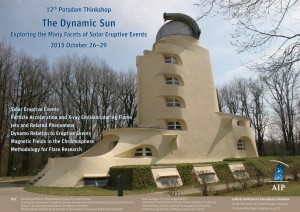Simultaneous Observations of a Near-Relativistic Electron Spike Event by Both STEREO Spacecraft
Andreas Klassen (University of Kiel)
Abstract. Solar electron spike events are a special subclass of impulsive near-relativistic electron events characterized by their short duration, symmetric time profile, and their strong anisotropic pitch angle distribution. We present first simultaneous observations of an electron spike event detected by both close-spaced STEREO spacecraft on 2 May 2014. At that time the longitudinal separation angle between STEREO-A (STA) and STEREO-B (STB) was 38 degrees. The spikes at both spacecraft are characterized by very short durations of < 12 minutes and almost identical and symmetric time profiles. They exhibit similar properties in durations, pitch angle distributions, energy spectra, and peak intensities. The spike parent source was situated close to the STA nominal magnetic foot-point and was separated by 48 degrees from STB foot-point. The intensity distribution and the relative onset timing behaved opposite to what is expected: STB measured a higher intensity and an earlier onset than the nominally better connected STA. We suggest that the spike electrons undergo a substantial non-radial injection into interplanetary space from the parent source (flare), and propagate in a strong non-radial diverging magnetic field. We show that because of the spike properties it is evident that, irrespective of how the electrons were injected into the IP medium, the en route particle scattering conditions along the propagation paths to STA and STB were very similar. Evidently both s/c detected different parts of the same beam whose angular extension was at least 38 degrees at 1 AU, comparable to the orbital separation between STA and STB.
Contributed Talk

Write a comment Close comment form